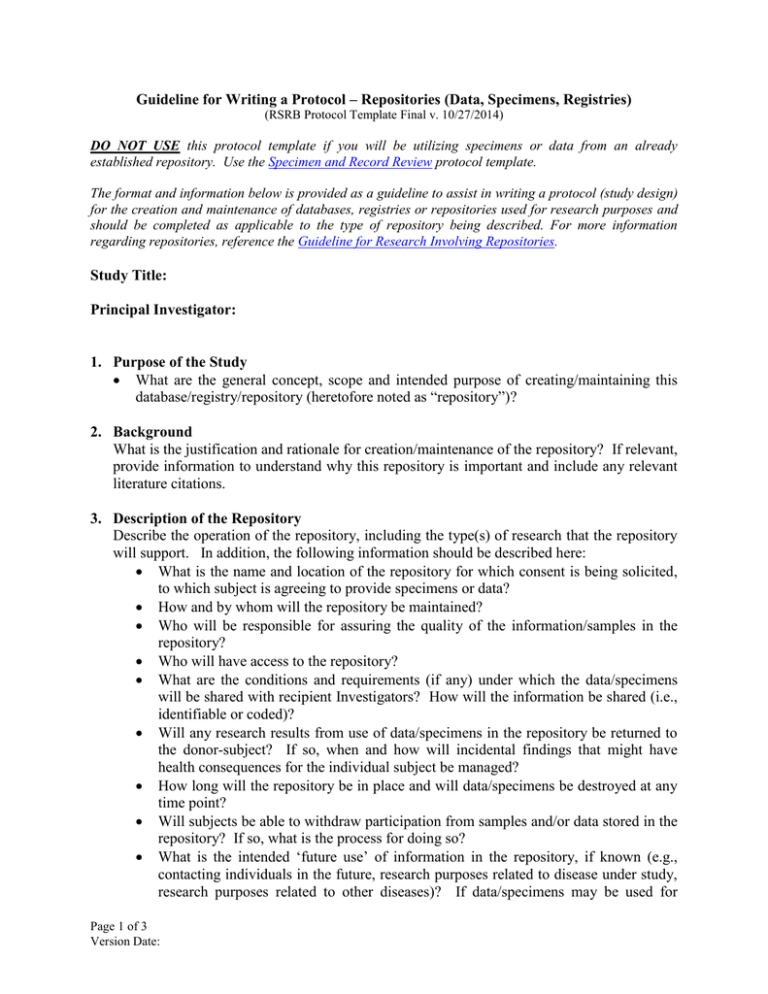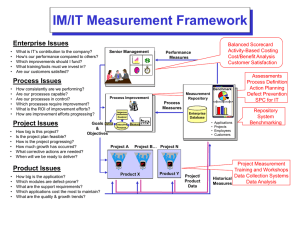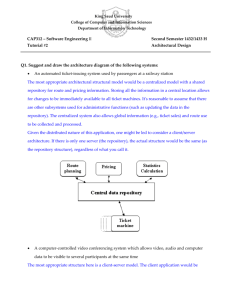Protocol Template Repositories
advertisement

Guideline for Writing a Protocol – Repositories (Data, Specimens, Registries) (RSRB Protocol Template Final v. 10/27/2014) DO NOT USE this protocol template if you will be utilizing specimens or data from an already established repository. Use the Specimen and Record Review protocol template. The format and information below is provided as a guideline to assist in writing a protocol (study design) for the creation and maintenance of databases, registries or repositories used for research purposes and should be completed as applicable to the type of repository being described. For more information regarding repositories, reference the Guideline for Research Involving Repositories. Study Title: Principal Investigator: 1. Purpose of the Study What are the general concept, scope and intended purpose of creating/maintaining this database/registry/repository (heretofore noted as “repository”)? 2. Background What is the justification and rationale for creation/maintenance of the repository? If relevant, provide information to understand why this repository is important and include any relevant literature citations. 3. Description of the Repository Describe the operation of the repository, including the type(s) of research that the repository will support. In addition, the following information should be described here: What is the name and location of the repository for which consent is being solicited, to which subject is agreeing to provide specimens or data? How and by whom will the repository be maintained? Who will be responsible for assuring the quality of the information/samples in the repository? Who will have access to the repository? What are the conditions and requirements (if any) under which the data/specimens will be shared with recipient Investigators? How will the information be shared (i.e., identifiable or coded)? Will any research results from use of data/specimens in the repository be returned to the donor-subject? If so, when and how will incidental findings that might have health consequences for the individual subject be managed? How long will the repository be in place and will data/specimens be destroyed at any time point? Will subjects be able to withdraw participation from samples and/or data stored in the repository? If so, what is the process for doing so? What is the intended ‘future use’ of information in the repository, if known (e.g., contacting individuals in the future, research purposes related to disease under study, research purposes related to other diseases)? If data/specimens may be used for Page 1 of 3 Version Date: future research that is not yet specifically identified, state that here. Also, indicate whether information may be shared with other institutions or transferred to other institutions. Will subjects be re-contacted regarding information in the repository? Will subjects be contacted in the future regarding use of data/specimens in the repository? If so, ensure the consent form adequately informs subjects of the intention for future contact and includes a statement to opt in to future contact. Please note that this is required for future testing that may be genetic in nature, according to the Policy on Research Involving Genetic Testing. 4. Study Population How many subject specimens/records will be included in the repository? Or, indicate if enrollment will be unlimited due to the nature of the proposed activity. What are the intended gender and age range of subjects included in the repository? What are the intended racial and ethnic distributions of the subjects included in the repository? Provide justification for any enrollment restrictions based upon race or ethnic origin. What are the criteria that define who will be eligible and who will not be eligible for inclusion in the repository (should support the purpose of the study)? 5. Subject Identification and Recruitment How will subjects be identified and recruited for participation in the repository? 6. Informed Consent How will consent be obtained (e.g., written consent, oral script, information letter)? Or, Provide justification for a waiver of consent or documentation of consent (see Guideline for Informed Consent). Note: If subjects will provide consent via checkbox option on an active study’s RSRB approved consent, a waiver of consent should be requested for the purposes of this repository application. If subjects will be recruited outside the context of an active RSRB approved study, a separate written consent form or oral consent script may be utilized. A waiver of documentation of consent must be requested (and justified) in the event oral consent will be obtained. 7. Risks and Benefits 7.1. Risks: What are the potential risks of conducting this study (e.g., related to the collection of any biological samples or related to any potential breach of confidentiality related to the information being collected)? What protections will be put in place to prevent and/or minimize any potential risks? 7.2. Benefits: What are the possible benefits from participation in the research? If there are no possible benefits, state no benefit. In most cases, contributing data/specimens to a repository, offers no benefit to subjects. Page 2 of 3 Version Date: 8. Data Storage and Confidentiality How will data pertaining to the subject’s participation be stored and who will have access to the data? How will the data be secured to maintain confidentiality of the data (e.g., coding data, using a secure data storage mechanism to prevent unauthorized access to the data, encryption of devices)? Will subject identifiers be collected (e.g., name, medical record number, date of birth, date of visit)? If so, specify if/when identifiers will be removed from the data set. NOTE: To ensure adequate encryption of files stored on portable devices such as laptops, tablets, memory sticks, etc., contact Information Technology (URMC website or UR website). For instruction regarding encryption of emails containing PHI see the Information Systems Email guidance. For information in regard to maintaining subject privacy, the HIPAA website provides frequently asked questions, or contact the HIPAA privacy officer for assistance. 9. REFERENCES Provide complete, numbered references for all citations listed in the order that they appear. Page 3 of 3 Version Date:


